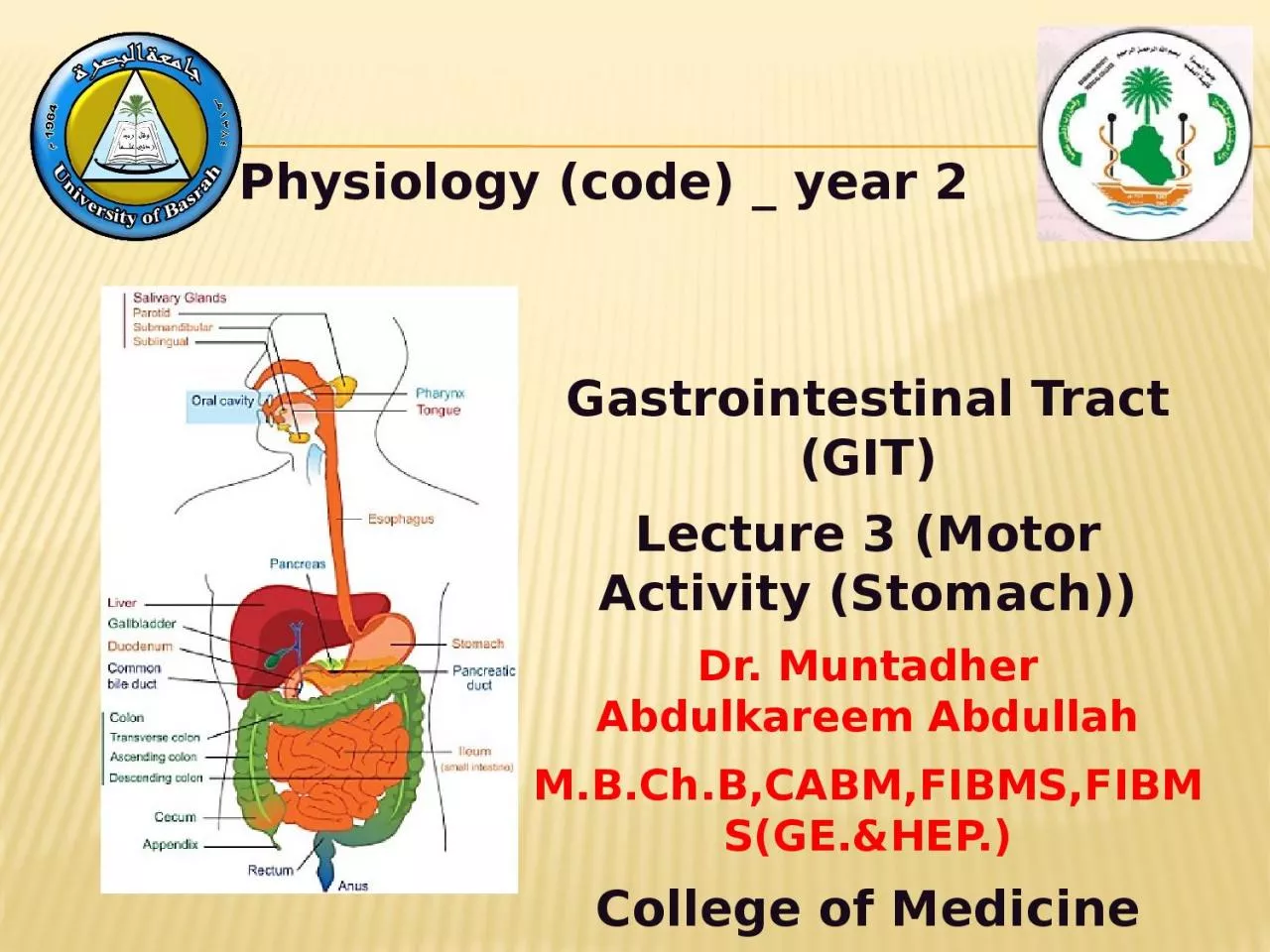

Gastrointestinal Tract GIT Lecture 3 Motor Activity Stomach Dr Muntadher Abdulkareem Abdullah MBChBCABMFIBMSFIBMSGEampHEP College of Medicine University of Basrah University of BasrahCollege of MedicinePhysiology Department ID: 932476
Download Presentation The PPT/PDF document "Physiology (code) _ year 2" is the property of its rightful owner. Permission is granted to download and print the materials on this web site for personal, non-commercial use only, and to display it on your personal computer provided you do not modify the materials and that you retain all copyright notices contained in the materials. By downloading content from our website, you accept the terms of this agreement.
Slide1
Physiology (code) _ year 2
Gastrointestinal Tract (GIT)
Lecture 3 (Motor Activity (Stomach))
Dr. Muntadher Abdulkareem AbdullahM.B.Ch.B,CABM,FIBMS,FIBMS(GE.&HEP.)College of MedicineUniversity of Basrah
Slide2University of Basrah-College of Medicine-Physiology Department
1
Objectives:1.Describe the motor functions of the stomach and the control of that functions.2.Describe the functional disorders.
Slide3Stomach
The stomach can be divided into: the
fundus, body and the antrum
. University of Basrah-College of Medicine-Physiology Department2
Slide4main function of the stomach are:
Storage of food until digested. When food enters the stomach a vagel
reflex greatly reduces the tone in the muscular wall of the body of the stomach, so that the wall can bulge progressively outward accommodating greater and greater quantities of food up to a limit of about (1 liter), this process is called receptive relaxation
.University of Basrah-College of Medicine-Physiology Department3
Slide52. Mixing of food with gastric secretion until it forms a semi fluid mixture called
chyme. When the stomach is filled, weak peristaltic constrictor waves called mixing waves, move toward the antrum
along the stomach wall approximately once every 20 seconds. As the constrictor waves progress from the body of the stomach into the antrum, they become more intense, providing powerful peristaltic constrictor rings that force the
antral contents under high pressure toward the pylorus.3. Slow emptying of chyme to the duodenum at a rate suitable for proper digestion and absorption by the small intestine.University of Basrah-College of Medicine-Physiology Department
4
Slide6Gastric motility
:a. Peristalsis: peristaltic contractions are initiated near the
fundal-body border and proceed caudally, producing a peristaltic waves that propels the food towards the pylorus, which occur every 20 sec. and are produced by periodic changes in membrane potential, called slow waves.
b. Retropulsion (mixing): it is the back and forth movement of the chyme caused by the forceful propulsion of food against the closed pyloric sphincter.University of Basrah-College of Medicine-Physiology Department5
Slide7All food enters the stomach passes to the duodenum and this is regulated by the stomach itself. Normal diet takes 3 hours to be emptied to the duodenum.
Fasting for 12 hours → increases
antral peristalsis → hunger contraction accompanied with pain. This is considered as the pacemaker of the stomach.
University of Basrah-College of Medicine-Physiology Department6
Slide8Factors affecting gastric emptying
: 1.Gastric factors: these factors arises from stomach and includes:
a. Nervous factors: stimulated by food in the stomach → increase motility and secretion through enteric nervous system → increase stomach emptying due to increased
antral peristalsis (enteric nervous system and vagus nerve) b. Humoral factors: stimulated by food in stomach → increase in gastrin
secretion → increase in motility,
secretion, and
antral
peristalsis.
University of Basrah-College of Medicine-Physiology Department
7
Slide92. Duodenal factors: arises from duodenum and mediated by
entero-gastric reflex.
a. Nervous factors: entero
-gastric reflex arising from duodenum will go to the stomach to inhibit the antral peristalsis through myenteric nervous system and sympathetic system. The main stimuli for entero-gastric reflex are:1. Over distention of duodenum.
2. Irritation of duodenum.
3. Hyper acidic
chyme
in duodenum.
University of Basrah-College of Medicine-Physiology Department
8
Slide10. The pH of
chyme (4.5), the duodenal mucosa used to be alkaline medium so when acidic chyme
comes to the duodenum it will be neutralized by pancreatic juice and biliary secretion but when the chyme
is too acidic it will causes the irritation of duodenal mucosa → enterogastric reflex → inhibit stomach emptying.4. Hyperosmolar chyme: osmolarity
in the lumen of duodenum is 300
mosm
/L. When the
chyme
entering duodenum is
hyperosmolar
(>300mos/L) → stimulate the
enterogastric
reflex then water will get out from mucosal cells of duodenum to the lumen.
University of Basrah-College of Medicine-Physiology Department
9
Slide11b. Humoral
factors: fat or acid or both in duodenum will inhibit the antral peristalsis due to release of hormones. Fat stimulates CCK-PZ secretion, acid stimulate release of
secretin, both fat and acid in chyme stimulate the release of gastric inhibitory peptide.
University of Basrah-College of Medicine-Physiology Department10
Slide12Recap:
The stomach can be divided into: the fundus, body and the antrum. The gastric motility achieved by Peristalsis and
Retropulsion (mixing) movements. All food enters the stomach passes to the duodenum and this is regulated by the stomach itself. Normal diet takes 3 hours to be emptied to the duodenum.Questions:
Write T or F against each of following statements:1. Receptive relaxation of the stomach under the control of facial nerve.2. Normal diet takes 12hours to be emptied to the duodenum. University of Basrah-College of Medicine-Physiology Department11
Slide13Thank You